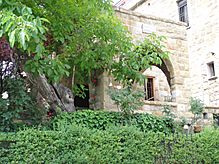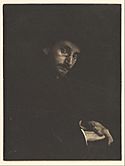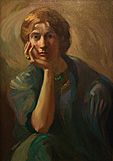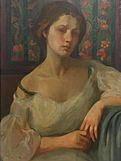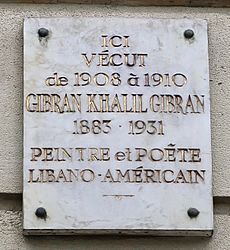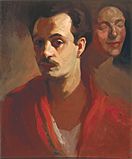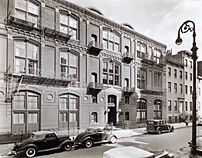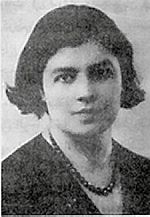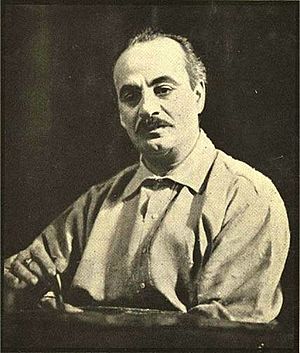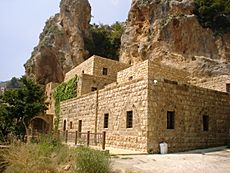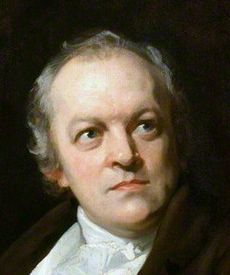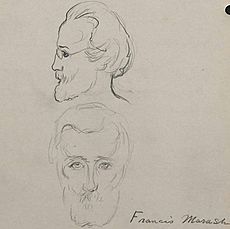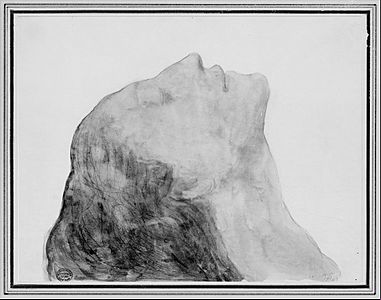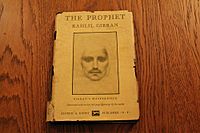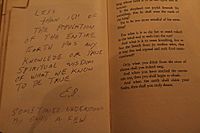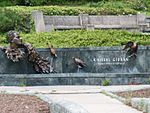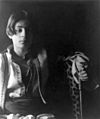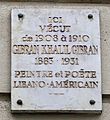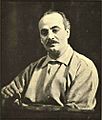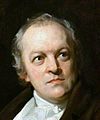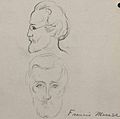Kahlil Gibran facts for kids
Quick facts for kids
Kahlil Gibran
|
|
|---|---|
| جُبْرَان خَلِيل جُبْرَان | |
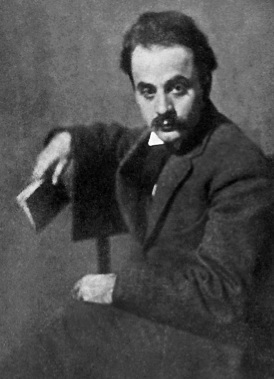
Gibran in 1913
|
|
| Born |
Gibran Khalil Gibran
January 6, 1883 Bsharri, Mount Lebanon Mutasarrifate, Syria, Ottoman Empire
|
| Died | April 10, 1931 (aged 48) New York City, United States
|
| Resting place | Bsharri, modern-day Lebanon |
| Nationality | Lebanese and American |
| Occupation |
|
|
Notable work
|
The Prophet, The Madman, Broken Wings |
| Movement | Mahjar (Arabic literature), Symbolism |
| Signature | |
 |
|
Gibran Khalil Gibran (pronounced kah-LEEL ji-BRAHN), often known as Kahlil Gibran, was a famous Lebanese-American writer, poet, and artist. He was also seen as a philosopher, though he didn't call himself one. He is most famous for his book The Prophet, which was first published in 1923. This book has become one of the best-selling books ever, translated into over 100 languages.
Gibran was born in a small village in what is now Lebanon. His family was Maronite Christian. In 1895, when he was 12, he moved with his mother and siblings to the United States. They settled in Boston. His mother worked as a seamstress. Gibran went to school there, and his artistic talent was quickly noticed. A teacher introduced him to a photographer and publisher named F. Holland Day.
At 15, Gibran returned to his home country to study Arabic literature and French in Beirut. He came back to Boston in 1902 after his youngest sister died. The next year, he lost his older half-brother and his mother. His remaining sister, Marianna, supported them by working in a dress shop.
In 1904, Gibran's drawings were shown for the first time in Boston. His first book in Arabic was published in 1905. With help from a new friend, Mary Haskell, Gibran studied art in Paris from 1908 to 1910. In 1911, Gibran moved to New York City. His first English book, The Madman, came out in 1918. He also started writing The Prophet.
Gibran's artwork was shown in galleries in 1914 and 1917. He also wrote many letters to a writer named May Ziadeh starting in 1912. In 1920, Gibran helped restart the Pen League with other Arab writers. He passed away at 48 in 1931. By then, he was well-known for his writing. His body was brought back to his home village in Lebanon, where a museum now stands.
Gibran's life was a mix of different ideas. He explored many themes in his writing and used different writing styles. Many people see him as a very important influence on Arabic poetry and literature in the early 1900s. His paintings often showed his personal feelings, using spiritual and mythical symbols. His large collection of work is seen as a gift to people everywhere.
Contents
Life Story of Kahlil Gibran
Early Life and Family
Kahlil Gibran was born on January 6, 1883, in Bsharri, a village in what was then Ottoman Syria (now Lebanon). His parents, Khalil Sa'ad Gibran and Kamila Rahmeh, were Maronite Christian. They taught Gibran to be accepting of different religions. Kamila was 30 when Gibran was born. He had two younger sisters, Marianna and Sultana, and an older half-brother, Boutros.
Gibran's family was poor. In 1888, he started school in Bsharri, where he learned Arabic, Syriac, and basic math. His father had problems with money and was briefly put in prison. Because of this, his family's property was taken away. His mother, Kamila, decided to move to the United States. On June 25, 1895, she left for New York with Boutros, Gibran, Marianna, and Sultana.
The family settled in Boston, which had a large Syrian-Lebanese community. Gibran started the Josiah Quincy School in September 1895. He was placed in a special class to learn English. His name was written as 'Kahlil Gibran' by mistake, and he used that spelling in English from then on. His mother worked as a seamstress, selling lace and linens. His half-brother Boutros opened a shop.
Gibran also joined an art school at Denison House. His teachers there introduced him to F. Holland Day, a photographer and publisher. Day saw Gibran's talent and encouraged him. In 1898, Gibran met Josephine Preston Peabody, a writer who was eight years older than him. He developed strong feelings for her. That same year, a publisher used some of Gibran's drawings for book covers.

Gibran's mother and half-brother wanted him to learn more about his own culture. So, at age 15, Gibran went back to Lebanon. He studied Arabic literature and French for three years at the Collège de la Sagesse in Beirut. In his last year, he helped create a student magazine and was named the "college poet." Gibran graduated with high honors at 18. He then traveled to Paris to study painting, visiting Greece, Italy, and Spain along the way.
On April 2, 1902, his sister Sultana died at 14, likely from tuberculosis. Gibran returned to Boston. The next year, on March 12, Boutros died from the same illness. His mother passed away from cancer on June 28. Two days later, Josephine Preston Peabody left him. His sister Marianna supported them by working at a dressmaker's shop.
First Art Show and Meeting Mary Haskell
Gibran had his first art show in January 1904 in Boston. There, he met Mary Haskell, a school headmistress who was nine years older. They became close friends for the rest of Gibran's life. Mary Haskell spent a lot of money to support Gibran. She also helped him edit all his English writings. They were briefly engaged between 1910 and 1911, but Haskell decided they should remain friends. She later married someone else but stayed Gibran's close friend and supporter.
In 1905, Gibran's first written work, A Profile of the Art of Music, was published in Arabic. His next book, Nymphs of the Valley, also in Arabic, came out the following year.
In July 1908, with Mary Haskell's help, Gibran went to Paris to study art at the Académie Julian. While in Paris, Gibran met Syrian thinkers who wanted freedom from Ottoman rule. Some of Gibran's writings, which shared these ideas, were later banned by the Ottoman government. In June 1910, Gibran visited London with friends.
Moving to New York and Growing Fame
Gibran returned to New York City in October 1910. By February 1911, he joined a Syrian organization in Boston. He gave talks there to promote freedom from Ottoman rule in Syria. He then moved to New York City and found a studio at the Tenth Street Studio Building. He lived there until his death, calling it "The Hermitage."
In 1912, his book Broken Wings was published in Arabic in New York. Gibran sent a copy to Lebanese writer May Ziadeh in Egypt and asked for her thoughts. Gibran and Ziadeh never met in person. Their relationship was mainly through letters, where they discussed their writings.
In 1913, Gibran started writing for Al-Funoon, an Arabic magazine. His book A Tear and a Smile was published in Arabic in 1914. In December of that year, his artwork was shown at the Montross Gallery. This caught the eye of American painter Albert Pinkham Ryder. After Ryder's death in 1917, Gibran's poem about him was widely shared, making Gibran's name known in America.
The Madman, The Pen League, and The Prophet
In 1916, Gibran helped the Syrian–Mount Lebanon Relief Committee. This committee helped people suffering from a famine in Mount Lebanon. The same year, Gibran met Lebanese author Mikhail Naimy. Naimy became a close friend and later wrote about Gibran's life. In 1917, two exhibitions of Gibran's drawings were held in New York and Boston.
Most of Gibran's early writings were in Arabic, but after 1918, most were in English. His first English book, The Madman, was published in 1918. In 1920, Gibran helped restart the New York Pen League with other Arab writers. The same year, The Tempests was published in Arabic, and The Forerunner in New York.
In 1921, doctors told Gibran to rest for six months. In 1922, he was told to stay away from cities. He rented a cottage by the sea in Scituate for three months. He later said this time was refreshing and he wrote some of his best Arabic poems there.
In 1923, The New and the Marvelous was published in Arabic. That same year, The Prophet was published in New York. Even though some critics didn't like it at first, The Prophet sold very well. Gibran met poetess Barbara Young at a reading of The Prophet. She sometimes worked as his secretary without pay from 1925 until his death.
Later Years and Passing
Sand and Foam was published in 1926, and Jesus, the Son of Man in 1928. In early 1929, Gibran was diagnosed with an enlarged liver. He wrote to his friend Naimy that he was told not to work for a full year, which he found harder than being sick. His last book published during his life was The Earth Gods, on March 14, 1931.
Gibran was taken to St. Vincent's Hospital, Manhattan, on April 10, 1931. He died that same day at 48 years old. The cause of death was reported as cirrhosis of the liver and early tuberculosis in one lung.
Gibran had wished to be buried in Lebanon. His body was first kept in Boston. Then, on July 23, it was taken by ship to Lebanon. Gibran's body arrived in Bsharri in August. It was placed in a nearby church until a cousin bought the Mar Sarkis Monastery. This monastery is now the Gibran Museum, where Gibran is buried.
Gibran left all future money from his books in America to his hometown of Bsharri. This money was to be used for "civic betterment," meaning to improve the town. He also left the contents of his art studio to Mary Haskell. In 1950, Haskell gave her collection of Gibran's art to the Telfair Museum of Art in Savannah, Georgia. This is the largest public collection of his visual art in the United States.
Kahlil Gibran's Works
Writings: Forms, Themes, and Language
Gibran wrote in many different styles, including poetry, short stories, fables, and essays. He also wrote some plays that were published after he died. In his writings, Gibran explored important topics like religion, justice, love, happiness, and death. His style was often unique, using symbols and showing a deep love for his home country.
He used a clear and simple vocabulary in both Arabic and English. This made his spiritual and universal themes easy to understand. In 1924, he published a poem called "You Have Your Language and I Have Mine." This was his response to people who criticized his Arabic writing style.
Influences on Gibran's Writing
A huge influence on Gibran was the Bible, especially the King James Version. The stories and poems in the Bible shaped his own parables and rhythms. He also admired the style of the Bible.
The works of English poet and artist William Blake were also very important to Gibran. Gibran agreed with Blake's strong views on the world. He called Blake "the God-man" and praised his drawings and vision.
Gibran also greatly admired Syrian writer Francis Marrash. Gibran had studied Marrash's works in school. Gibran's own writings often sound like Marrash's style. They share many ideas about freedom, education, women's rights, and the problems in society. Marrash's idea of universal love especially influenced Gibran.
American poet Walt Whitman also influenced Gibran. Gibran followed Whitman's idea that all people are connected and that nature is wonderful.
Visual Art: Overview and Style
Gibran wanted to be a Symbolist painter. He mainly used oil paint between 1908 and 1914. Before and after this time, he mostly used pencil, ink, watercolor, and gouache. He once wrote that J. M. W. Turner was the greatest English artist. Gibran was inspired by Turner's painting The Slave Ship to use bright, pure colors in his own work.
Gibran created more than 700 artworks, including many portraits. His art can be seen in the Gibran Museum in Bsharri, Lebanon, and in several museums in the United States and Mexico.
Gallery of Kahlil Gibran's Art
-
Untitled (Rose Sleeves), 1911 (Telfair Museums)
-
Towards the Infinite (Kamila Gibran, mother of the artist), 1916 (Metropolitan Museum of Arts)
Kahlil Gibran's Beliefs
Religious Views
Gibran grew up as a Maronite Christian. However, he was also influenced by Islam, especially the spiritual ideas of the Sufis. He knew about the history of conflict in Lebanon. This made him believe that all religions are fundamentally united.
Besides Christianity, Islam, and Sufism, Gibran's spiritual ideas were also shaped by theosophy and Jungian psychology.
Around 1911–1912, Gibran met ʻAbdu'l-Bahá, the leader of the Baháʼí Faith, who was visiting the United States. Gibran drew his portrait. This meeting deeply affected Gibran. It later inspired him to write Jesus the Son of Man. This book tells the story of Jesus through the words of 77 people who knew him.
In his poem "The Voice of the Poet" (1914), Gibran wrote:
|
انت اخي وانا احبك ۔ |
You are my brother and I love you. |
| —Translated by H. M. Nahmad |
Political Ideas
Gibran believed that Arabic should be the main language of Syria, seeing Syria as a geographical area. When he met ʻAbdu'l-Bahá in 1911–12, Gibran admired the teachings of peace. However, he also argued that "young nations like his own" should be free from Ottoman control. He wrote the famous poem "Pity the Nation" during these years.
On May 26, 1916, Gibran wrote a letter about the Great Famine of Mount Lebanon. He said the famine was caused by the Turkish government. He mentioned that 80,000 people had already died from starvation. Gibran dedicated a poem called "Dead Are My People" to those who died in the famine.
When the Ottomans left Syria after World War I, Gibran drew a happy picture called "Free Syria." This drawing was printed on the cover of an Arabic newspaper. Gibran strongly believed in Syrian independence.
Kahlil Gibran's Legacy
The popularity of The Prophet grew a lot in the 1960s. It became very popular with the American counterculture and later with New Age movements. Since it was first published in 1923, The Prophet has always been available to buy. It has been translated into over 100 languages, making it one of the most translated books in history. It was also one of the best-selling books of the 20th century in the United States.
Elvis Presley often referred to Gibran's The Prophet throughout his life. He received his first copy as a gift in 1956. His copy with notes is still kept in Lebanon. A line from Gibran's book Sand and Foam (1926) was used by John Lennon. It was put into the song "Julia" by the Beatles on their 1968 album.
Johnny Cash recorded The Eye of the Prophet as an audio book. He also talked about Gibran's work on his 2003 album Unearthed. British singer David Bowie mentioned Gibran in his 1970 song "The Width of a Circle". Gibran's book A Tear and a Smile became popular in the hippie culture of the 1960s. In 2018, a musical called Broken Wings was created based on Gibran's novel of the same name.
Memorials and Honors
Many places, monuments, and schools around the world are named after Gibran. These include the Gibran Museum in Bsharri, a memorial plaque in Boston, the Gibran Khalil Gibran Garden in Beirut, and the Kahlil Gibran Memorial Garden in Washington, D.C. There are also schools named after him in Brooklyn and Yonkers, NY.
In 2009, a crater on the planet Mercury was named in his honor.
Family Connections
American sculptor Kahlil G. Gibran (1922–2008) was a cousin of the famous writer. The Katter political family in Australia is also related to Gibran.
Images for kids
-
The Collège maronite de la Sagesse in Beirut
-
Untitled (Rose Sleeves), 1911 (Telfair Museums)
-
Towards the Infinite (Kamila Gibran, mother of the artist), 1916 (Metropolitan Museum of Arts)
-
Portrait of William Blake by Thomas Phillips (detail)
-
Handwritten notes in Elvis Presley's copy of The Prophet
-
Handwritten notes in Elvis Presley's copy of The Prophet
-
Gibran Khalil Gibran Garden in Beirut
-
Kahlil Gibran Memorial Garden in Washington, D.C.
See also
 In Spanish: Yibrán Jalil Yibrán para niños
In Spanish: Yibrán Jalil Yibrán para niños



